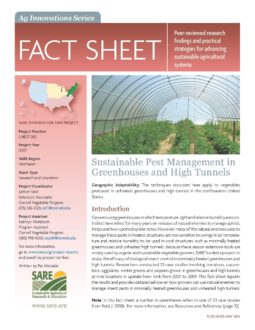Growers using greenhouses in which temperature, light and relative humidity are controlled have relied for many years on releases of natural enemies to manage aphids, thrips and two-spotted spider mites. However, many of the natural enemies used to manage these pests in heated structures are too sensitive to swings in air temperature and relative humidity to be used in cool structures such as minimally heated greenhouses and unheated high tunnels.
Because these season extension tools are widely used by organic and sustainable vegetable growers, SARE funded a project to study the efficacy of biological insect control in minimally heated greenhouses and high tunnels. Researchers conducted 23 case studies involving tomatoes, cucumbers, eggplants, winter greens and peppers grown in greenhouses and high tunnels at nine locations in upstate New York from 2007 to 2009. This fact sheet reports the results and provides detailed advice on how growers can use natural enemies to manage insect pests in minimally heated greenhouses and unheated high tunnels.
Want more information? See the related SARE grant:
